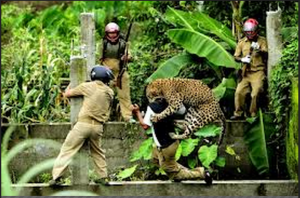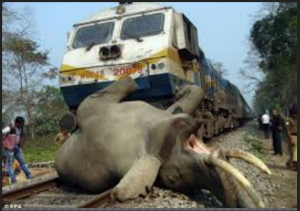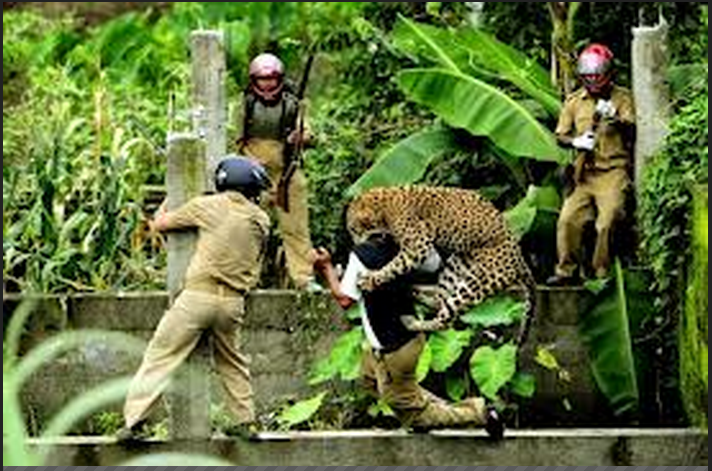They were overjoyed. They sang his praises. They almost worshipped him like a demi-God. The man was Jim Corbett, who had gunned down the notorious man-eaters of Garhwal and Kumaon. But again, he was a hunter-turned-conservationist. Also, the incidences of man-animal conflicts were low. You could almost praise someone who killed the leopard who went around killing people. Although, these people were living in the leopard’s home. It did nothing wrong in feeling free to do its will in its own home. Thus began the gruesome meets of Man and Beast, in many forest regions of India : better known as Man-Animal Conflicts.
Throughout the history of the planet, Man has hunted animals and vice-versa. But, both of them were tied by the natural limits and balance. Both had almost equal strengths and weaknesses. That was, until Man developed something even more deadly than his weapons. He developed an arrogant mind. He began to believe that he alone had the right to own the land and live on it, while the other creatures would subjugate to his needs or perish. Since the advent of this mindset, the perils of man-animal conflicts came to the fore.
Causes for Man-Animal Conflict :
- As the human population is increasing and cities are spilling over its boundaries, humans are encroaching upon the habitat of the wild animals. Population explosion of human beings is the major cause for man-animal conflicts. We need more space to live, so we enter the animals’ homes. The animals have nowhere else to go and when confronted they attack as defense against their own lives.

- As human population extends to wild animal habitats, natural wildlife range is displaced. Reduction in availability of natural prey sources leads to wild animals seeking alternate sources. Alternately, new resources created by humans draw wildlife resulting in conflict.
For example, when large cattle farms are created in buffer zones of natural reserves, wild carnivores tend to be attracted by the easy resource of prey created by human beings.
- The population density of wildlife and humans increase with overlaps in geographical areas used increasing their interaction thus resulting in increased physical conflict. Byproducts of human existence offer un-natural opportunity for wildlife in the form of food and shelter, resulting in increased interference and destructive threat for both man and animals.
For example, while camping in forests, when human beings throw away food (non-vegetarian ), wild predators are attracted to the camps and a mishap may occur.
In Alaska, U.S. ,in the log cabins and camp houses in and around the Yellowstone National Park witnesses the dangerous Grizzly Bear attacks on humans simply because they are attracted by the food left in the garbage bins outside the cabins.
- Competition for food resources also occurs when humans attempt to harvest natural resources such as fish and grassland pasture.
For example, when humans try to go fishing in mangrove regions of the Sundarbans in West Bengal, India , many and frequent fatal conflicts occur between the fishermen and the royal Bengal tigers.
One can also find cases of humans being stung to death by the Rock bees that build honeFor example, when humans try to go fishing in mangrove regions of the Sundarbans in West Bengal, India , many and frequent fatal conflicts occur between the fishermen and the royal Bengal tigers.
- One can also find cases of humans being stung to death by the Rock bees that build honeycombs in the Sundari trees in the Sundarbans. This occurs when humans try to harvest more than what Nature provides for them. The honey produced by these bees is valuable and thus, men risk their lives for the livelihood.
Consequences of Man-Animal Conflict :
- Loss of Life : Both animals and men lose their lives in the conflicts. Most of these physical encounters are the result of defense mechanisms on both sides.

Sometimes, wild animals like leopards and tigers enter sugarcane fields which were originally forests.
- Blockage of wildlife corridors : Most elephant deaths in India occur due to being hit by trains on railway tracks. This is because the train tracks are laid down on important wildlife corridors which are used by animals to move from one area of the forest to the other periodically and under specific stimuli.

- Loss of crop : Assam , West Bengal and nearby regions witness regular loss of tea plantations due to influx of wild elephants than go on a complete rampage. Most of these episodes end with death on both the sides : men and elephants.
- Loss of cattle : The infamous man-eaters of Madhya Pradesh came to light due to straying cattle into the core zones. Cattle being easy preys, the tigers followed the herd to their homes. They found still easier preys: humans. Thus began gunning down man-eater tigers but the very cause of them turning so was Man.
- Reduced habitat and safety of both men and wild animals.
- Drop in reproduction cycles and populations of major predators.
Regions with large number of man-animal conflicts :
- Maharasthra : Borivali, Ambegaon , Kolshet, etc. regions see monthly leopard visits in human settlements. Sometimes there is no mishap and sometimes there is.

- West Bengal : Sundarbans: Tigers usually kill fishermen that stray into core zones out of defense.
The hilly regions witness elephant attacks.
- Regions in the Terai and Shivaliks see many leopard attacks on hill settlements.
There are many such regions in India and worldwide where both animals and men live in constant fear of the other.
Lack of education and awareness about our rich biodiversity, ignorance and sheer arrogance of humans is to be blamed. Sometimes, the inefficiency of the Forest Department is also to be blamed for not relocating the villages in the core zones of national parks. It’s time we stopped claiming someone else’s home as ours.

Leave a Reply